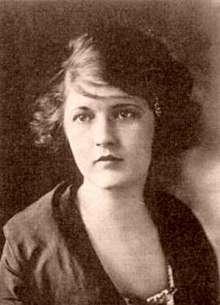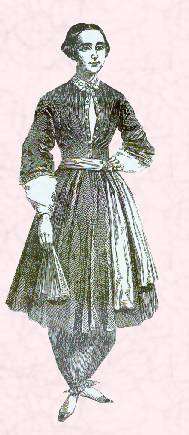Women's Suffrage and Western Women's Fashion through the early 1900s
Women's apparel in the early 20th century was often costly, inconvenient, and weighed heavily in regards to male courtship.[1] Despite the social pressures of normative feminine dress, some women, specifically those involved in the Women's Suffrage Movement, were intent on rebelling against the standards of women's dress. However, the 1920s was not the first decade to reject impractical female apparel. The Victorian dress reform paved the way for the more progressive and more politically aggressive women of the 1920s,[2] though the validity of such reforms, the New Woman in particular, has been criticized for emphasis on female empowerment through dress and manner rather than political efforts–noting a decline in American feminism in the 1930s and 1940s when fashions forged in the 1920s dress movement became more widely normalized and, in some ways, reverted to more restrictive dress and styles (see 1945–1960 in Western fashion).[3] Despite the subsequent decline in feministic ideology, the women of the 1920s' changing attitudes, reflected in their choice of apparel, had a lasting impression on modern feminist ideals that resurged in the 50s and 60s.[3] The New Woman's moxie was paradoxically evident in her lack of charm, exhibiting short bobbed haircuts, heavier makeup, and boyish frames.[4] It may seem as though the flapper mirrored a rebellion against femininity, but it was actually quite the opposite; it was meant to make the modern woman's life easier. The flapper's simplistic, straight-lined style was popularized by Coco Chanel, who's somewhat ironically remembered as "fashionable without being forward,"[5] as a way of liberating women the impractical designs that hindered modern women's ability to engage in physical activities.[6] "The newfound freedom to breathe and walk encouraged movement out of the house, and the Flapper took full advantage.”[2] Popular accessories now viewed as classics, such as strings of pearls and petite handbags, can also be traced back to the simplistic vision of Coco Chanel.[4] Other successful accessory designers of the Roaring 20s include that of Cartier and "strap bracelets" and Miriam Haskell with her "fashion jewelry"[7] (costume jewelry), but wealth wasn't a necessity for obtaining the flapper's look. Magazines provided sewing patterns to mimic chic Parisian trends, which fast-tracked the look's popularity by making them easily accessible to all those with a needle and thread,[7] the common woman. However, while standardizing practical women's attire promoted movement, it was also seen as highly provocative,[3] as the new dress (or lack thereof) served as a symbol of sexual freedom[2] as well as an indicator of supposed declining morals.[4] Flappers invested more importance on fun and panache than they did in moral character, idolizing figures such as Zelda Fitzgerald, wife of Modernist author F. Scott Fitzgerald, who was known for her flair, wit, and personal accomplishments as a writer and a professionally trained ballet dancer.[7] Completing her own American novel, Save Me the Waltz, in 1932, Zelda epitomized the mantra that inspired the New Woman's change in apparel: that "a woman can do anything a man can do" without compromising her femininity.[3] The flapper "smoked, drank, swore, drove fast, professed free love, and used makeup,"[4] and exercised sexual independence–re-positioning herself as an indelible force in Western society.[2]

Women's Dress and Activities Pre-Women's Suffrage

The women of the late 19th century changed their style from the big Victorian dresses to more “manageable, practical, streamlined outfits for modern women to engage in the activities of their more active lives."[8] Prior to the Women's Suffrage Movement, women were thought to be very fragile creatures so they were discouraged from playing sports."[8] However, with an increasing number of women protesting, there were more doctors who said that light physical activity for a woman was good. Because of this there was an increasing output of clothes to correspond, called rational dress. One specific piece of clothing was the sporting pantaloon or the women's bloomer.[9] Originally worn in America in the 1850s as a women's suffrage statement by Amelia Bloomer, it turned into the ideal costume for women riding bicycles, an activity that was not too strenuous for women in the late 19th century. This was a piece of clothing for women and the beginning of women wearing pants. This piece of clothing was for sports and outdoor activity.[10]
Accommodating the Emerging Modern Woman

Women in the 1910s across the world had to pick up what they were doing and go help in factories, supporting the jobs that their husbands no longer could do because of their involvement in World War I,[11] sparking the dress reform in which some women activists argued that clothes should be worn for convenience rather than comfort. This led to more practical clothing for women working in factories. The fashion was less restrictive than the Victorian era dress and had much less fabric that allowed women to move more fluidly in their activity. The newly found freedom of women made more women start to dress like men in an article written by Laura Doan[9] she examines the effect of women working increasingly in the field of the factory alongside the man domestically as well as abroad. More and more women started to take on very manly looks in their everyday lives. This is to say that some wore uniforms in order to work more efficiently. The great war had an impressive effect on women's fashion however many men still did not accept the new and changing woman as seen in political cartoon in Britain in which one girl is walking with another and one is wearing pants and the man continue to make jokes about it. Every woman wore accessories no matter your class or job. “From society lady to factory "girl," every woman wore a hat, stockings, shoes, and gloves in all seasons.”[8]
Women's Dress and Activities Post-Women's Suffrage

During the progressive era the clothes changed along with ideas about women.[4] Women in baseball during the progressive period tried out knickers for their uniform for a time. They first wore short skirts and long whole socks and then converted back to long skirts finally to rest upon knickers. Tennis was a sport that was appropriate for women to play, and in the early 1920s, there was a switch to more manageable clothing for women to wear. After the war and women's suffrage a new style came into play: the Flapper, much of which was influenced by film, radio, and women's newly found freedom to vote. This was an outfit that exposed the knee for the first time if stockings were worn, which was not always mandatory. This outfit was worn by young women in the 1920s and oftentimes was not approved of by older men and women of the time. The flapper was less of a style and more of a persona. It described a young revealing woman who did not have a lot of respect for the floor length skirt of yesterday. The flapper showed that women were able to express themselves more and show what they wanted to show of their bodies. Considering the lament in which the author of Flapper Jane[12] describes the flapper, this style was most likely looked down upon by much of the societies in that time period.
References
- Williams, Fannie Barrier (May 1913). "The Dress Burden". National Association Notes. 16 (5): 8–9 – via Women and Social Movements in the United States, 1600–2000 (ASP).
- Kriebl, Karen Joyce (1998). From Bloomers to Flappers: The American Women's Dress Reform Movement, 1840–1920 (PhD thesis). Ann Arbor, MI, USA: The Ohio State University.
- Freedmen, Estelle B. (1974). "The New Woman: Changing Views of Women in the 1920s". The Journal of American History. 61 (2): 372–393. doi:10.2307/1903954. JSTOR 1903954.
- Darnell, Paula Jean (1997). From Victorian to vamp: Women's clothing, 1900–1925 (M.S> thesis). University of Nevada. ProQuest 304359443.
- Madsen, Axel (1990). Chanel: A Woman of Her Own. New York: New York: Henry Holt and Company. p. 329.
- Cunningham, Patricia A. (2015). Reforming Women's Fashion, 1850–1920 : Politics, Health, and Art. The Kent State University Press. ISBN 978-1-63101-099-6.
- Jailer-Chamberlain, Mildred (September 2003). "Flappers in fashion the 1920s". Antiques & Collecting Magazine. 108 (7): 24–30. ProQuest 197167822.
- "Fashioning the New Woman: 1890–1925". Daughters of the American Revolution. 2014-04-11. Retrieved 2018-11-10.
- Doan, Laura L. (2006). "Topsy-Turvydom: Gender Inversion, Sapphism, and the Great War". GLQ: A Journal of Lesbian and Gay Studies. 12 (4): 517–542. doi:10.1215/10642684-2006-001. ISSN 1527-9375.
- Breward, Christopher (1995-05-15). The Culture of Fashion. Manchester University Press. ISBN 978-0-7190-4125-9.
- Haydu, Jeffery (1985). "Factory Politics in Britain and the United States: Engineers and Machinists, 1914–1919". Comparative Studies in Society and History. 27 (1): 57–85. doi:10.1017/S0010417500013669. JSTOR 178634.
- Ormsby, BLIVEN, Bruce (1925). "Flapper Jane". search.lib.byu.edu. Retrieved 2018-11-10.